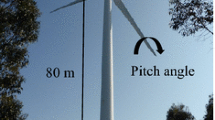Abstract
Wind turbines are designed to last about 20 years. However, information regarding the actual structural condition of the wind turbine throughout this period is very limited or even null. This situation prevents the exploitation of the full potential of the support structure of the turbine, including the extension of its period of life. This paper presents an overview of a dynamic monitoring system developed to monitor the structural integrity of utility-scale wind turbines. This monitoring system, based on automated techniques of operational modal analysis, aims to deliver important information regarding the actual condition of the wind turbine: early detection of structural changes (i.e. damage) and evaluation of fatigue condition of the support structure. In this paper, a special focus is given to the latter.


















Similar content being viewed by others
References
The European Wind Energy Association (EWEA) (2016) Wind in power—2015 European statistics
The European Wind Energy Association (EWEA) (2016) The European offshore wind industry—key trends and statistics 2015
Hu W-H, Thöns S, Rohrmann RG, Said S, Rücker W (2015) Vibration-based structural health monitoring of a wind turbine system. Part I: resonance phenomenon. Eng Struct 89:260–272. doi:10.1016/j.engstruct.2014.12.034
Devriendt C, Magalhães F, Weijtjens W, Sitter GD, Cunha Á, Guillaume P (2014) Structural health monitoring of offshore wind turbines using automated operational modal analysis. Struct Health Monit 13(6):644–659. doi:10.1177/1475921714556568
Oliveira G, Magalhães F, Cunha Á, Caetano E (2016) Development and implementation of a continuous dynamic monitoring system in a wind turbine. J Civil Struct Health Monit 6:343. doi:10.1007/s13349-016-0182-7
Iliopoulos A, Weijtjens W, Van Hemelrijck D, Devriendt C (2017) Fatigue assessment of offshore wind turbines on monopile foundations using multi-band modal expansion. Wind Energy 20(8):1463–1479
Veljkovic M, Heistermann C, Husson W, Limam M, Feldmann M, Naumes J, Pak D, Faber T, M. Klose, Fruhner K-U, Krutschinna L, Baniotopoulos C, Lavasas I, Pontes A, Ribeiro E, Hadden M, Sousa R, Silva L, Rebelo C, Simoes R, Henriques J, Matos R, Nuutinen J, Kinnunen H (2012) High-strength tower in steel for wind turbines (Histwin). Luxembourg
Magalhães F, Cunha Á (2011) Explaining operational modal analysis with data from an arch bridge. Mech Syst Signal Process 25:1431–1450
Peeters B, Roeck G (1999) Reference-based stochastic subspace identification for output-only modal analysis. Mech Syst Signal Process 13(6):855–878
Overschee P, Moor B (1996) Subspace identification for linear systems. Theory, implementation, applications. Kluwer Academic Publishers, Dordrecht
Peeters B, Van Der Auweraer H, Guillaume P, Leuridan J (2004) The PolyMAX frequency-domain method: a new standard for modal parameters estimation? Shock Vib 11:395–409
Allemang RJ (2003) The modal assurance criterion—twenty years of use and abuse. Sound Vib. 37(8):14–23
Magalhães F, Cunha Á, Caetano E (2009) Online automatic identification of the modal parameters of a long span arch bridge. Mech Syst Signal Process 23(2):316–332
Oliveira G (2016) Vibration-based structural health monitoring of wind turbines. PhD thesis. University of Porto, Faculty of Engineering. Porto, Portugal
Johnson RA, Wichern DW (2002) Applied multivariate statistical analysis. Prentice Hall, New Jersey
Magalhães F, Cunha Á, Caetano E (2012) Vibration based structural health monitoring of an arch bridge: from automated OMA to damage detection. Mech Syst Signal Process 28:212–228
Pelayo F, López-Aenlle M, Fernández-Canteli, A, Cantieni R (2011) Operational modal analysis of two wind turbines with foundation problems. In: Proceedings of 4th International Operational Modal Analysis Conference (IOMAC). Istanbul, Turkey
Jonkman J, Butterfield S, Musial W, Scott G (2009) Definition of a 5-MW Reference Wind Turbine for Offshore System Development National Renewable Energy Laboratory
Larsen T, Hansen A (2007) How 2 HAWC2, the user’s manual. Risø National Laboratory, Roskilde
HAWC2 web site (2016) HAWC2 model—NREL 5-MW Reference Wind Turbine. http://www.hawc2.dk
European Committee for Standardization (CEN) (2005) EN 1993-1-9 Eurocode 3: Design of steel structures—Part 1–9: Fatigue
Guideline GW, Lioyd G (2010) Guideline for the certification of wind turbines. Germanischer, Hamburg
Acknowledgements
The authors would like to acknowledge: (1) all the financial support provided by the Portuguese Foundation for Science and Technology (FCT) to ViBest/FEUP in the framework of the Project Dynamic Behaviour Monitoring for Structural Safety Assessment/National Network of Geophysics (National Programme for Scientific Re-equipment) (2) the Ph.D. Scholarship (SFRH/BD/79328/2011) provided by FCT to the first author; (3) the support given by INEGI, the wind turbine manufacturer Senvion and the wind turbine owner Cavalum.
Author information
Authors and Affiliations
Corresponding author
Ethics declarations
Conflict of interest
The authors declare that they have no conflict of interest.
Rights and permissions
About this article
Cite this article
Oliveira, G., Magalhães, F., Cunha, Á. et al. Dynamic monitoring system for utility-scale wind turbines: damage detection and fatigue assessment. J Civil Struct Health Monit 7, 657–668 (2017). https://doi.org/10.1007/s13349-017-0250-7
Received:
Accepted:
Published:
Issue Date:
DOI: https://doi.org/10.1007/s13349-017-0250-7




